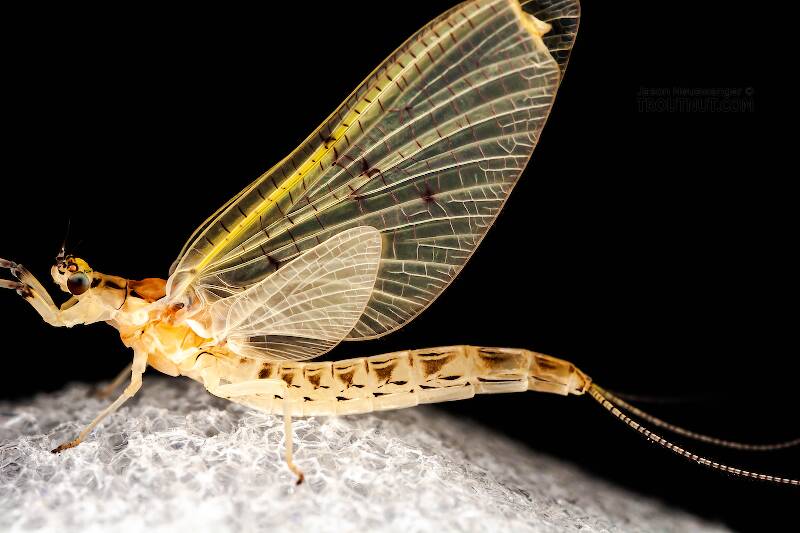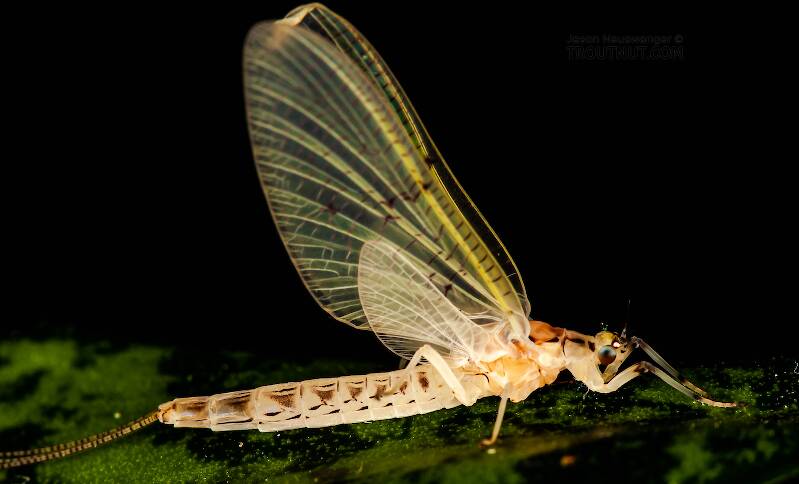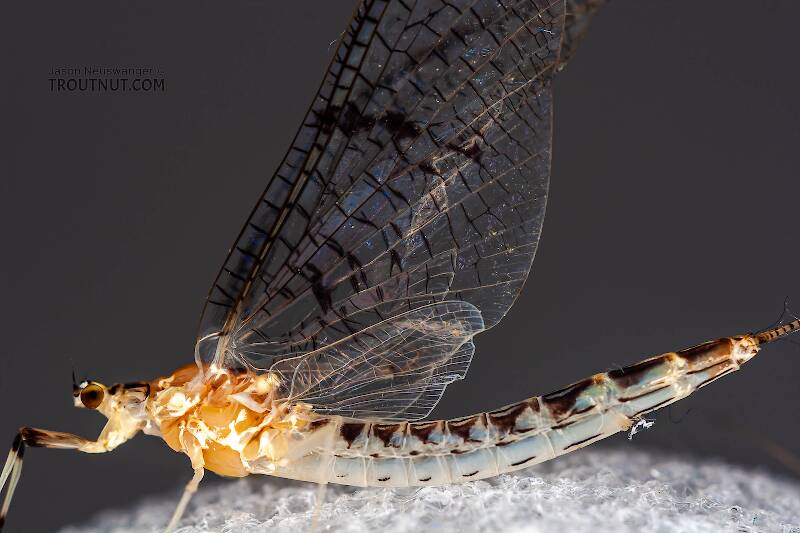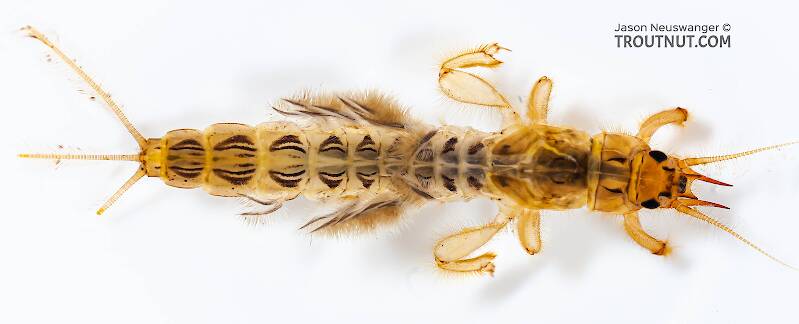
Blue-winged Olives
Baetis
Tiny Baetis mayflies are perhaps the most commonly encountered and imitated by anglers on all American trout streams due to their great abundance, widespread distribution, and trout-friendly emergence habits.


Mayfly Species Ephemera varia (Yellow Drakes)

Where & when
Adults of this species begin to show in mid-June in the Pennsylvania mountain ranges. The Catskills start a week or so later and hatches can be found in that region through early August. Farther north, and in the Upper Midwest, the hatch begins in mid-July and lasts into mid-August.Some authors say this hatch is more important in the Midwest than in the East.
In 46 records from GBIF, adults of this species have mostly been collected during June (57%), July (26%), May (9%), and August (7%).
In 8 records from GBIF, this species has been collected at elevations ranging from 341 to 2723 ft, with an average (median) of 1951 ft.
Species Range
Hatching behavior
Yellow Drakes drakes take a long time and make a lot of commotion trying to get off the water. Their imitations are effective.Several authors have remarked on the wide range of habitats from which this species will emerge. They apparently show no preference.
The hatch is best on cool, dry days. On cloudy days, according to Swisher and Richards in Selective Trout, the duns may emerge all day long. This behavior does not seem to be as prevalent as it is in Ephemera guttulata.
Spinner behavior
Time of day: Late evening to dusk, sometimes later
Habitat: Riffles, possibly elsewhere
There is some disagreement between authors about the precise spinner fall timing. It is generally late in the evening and may occur in the dark. I have encountered sporadic females ovipositing more than an hour before dark, and later I saw many more spinners in the air near the treetops.
Nymph biology
Current speed: Slow to medium
Substrate: Silt or sand and gravel
Ephemera varia Fly Fishing Tips
Don't let the common name of this species fool you into fishing a yellow-bodied fly. As my pictures show and other authors have pointed out, these mayflies have a creamy off-white body color. The duns are the same color as the spinners.According to Knopp and Cormier, trout may fill up on nymphs during the hatch and leave the duns and spinners untouched.
Physical description
Most physical descriptions on Troutnut are direct or slightly edited quotes from the original scientific sources describing or updating the species, although there may be errors in copying them to this website. Such descriptions aren't always definitive, because species often turn out to be more variable than the original describers observed. In some cases, only a single specimen was described! However, they are useful starting points.
Male Spinner
Wing length: 12 mm
A rather pale species; fore wing tinged with brownish except in anal region, hind wing pale; no dark blotch in apical third of wing beyond bullar stripe.
Frontal portion of head reddish, carina black; basal antennal segments black apically, filament brownish, tips pale. Vertex red-brown, blackish between and at bases of ocelli. Thoracic notum light red-brown. A wide blackish longitudinal stripe on each side of pronotum. Mesonotal scutellum pale; dark brown area anterior to this; middle portion of mesonotum paler yellowish, also a pale median line; anterolateral margins brown. Metanotum pale, with transverse dark band near center. Pleura yellowish; red-brown oblique streak before middle and hind leg. Sternum pale yellowish, anterior portion of mesosternum marked with brown. Coxa and trochanter of fore leg yellowish; femur rather olive brown, yellowish at base, apex darker; base and apex of tibia widely brown, remainder yellowish, apical half brown-tinged; tarsus yellowish brown, short basal joint, apical half of distal joint and all joinings, dark brown. Middle and hind legs creamy white, claws faintly tinged with brownish.
Wings hyaline; fore wing tinged with brownish except in anal region and near base, where wing membrane and veins are pale or colorless; stigmatic area most deeply tinged. Longitudinal veins yellowish to yellow-brown. Cross veins blackish, those of basal costal and subcostal spaces margined narrowly with dark brown, many in the disc with wider marginings. A wide dark purplish band at bulla, slightly curved, and extending backward as far as space above anterior branch of media, wide enough to cover three cross veins. Posterior to this and nearer the margin, a smaller dark purple cloud; another at basal end of long intercalary of media. No cloud in apical third of wing beyond bullar stripe, though a few cross veins in third space are margined. Hind wing pale; costa and subcosta yellowish, basal cross veins in these spaces pale purplish; all other veins colorless, none dark-margined. Outer margin may be faintly yellow.
Abdominal tergites largely purplish grey; lateral margins, postero-lateral angles and mid-dorsal area pale yellowish white. On tergites 2-9, a pair of purplish black oblique submedian streaks extend backward and laterad from anterior margin on each side, conjoined posteriorly; inner of these not extending beyond middle of tergite, outer a little longer. Between these and along outer margin, whitish spaces. Blackish markings along pleura much as in Ephemera blanda. Posterior margins of tergites, and middle portion of sternites, dark purplish. Sternites pale yellowish white. A black longitudinal streak on each side, and a dark mid-ventral streak on sternites 8 and 9, as in Ephemera blanda. Forceps base yellowish brown, forceps yellowish; second joint longer than in Ephemera simulans; penes rather narrower (fig. 82). Tails yellowish to greyish yellow, joinings dark brown.
The darker abdominal tergites and more extensive blotches in fore wing distinguish this species from the allied Ephemera blanda. Venter of abdomen paler, wings less extensively dark-margined, body paler than Ephemera simulans. Nymph shown in fig. 80.
Specimens of the Mayfly Species Ephemera varia
1 Female Dun

1 Female Spinner

1 Nymph
Start a Discussion of Ephemera varia
References
- Arbona, Fred Jr. 1989. Mayflies, the Angler, and the Trout. Nick Lyons Books.
- Caucci, Al and Nastasi, Bob. 2004. Hatches II. The Lyons Press.
- Fauceglia, Ted. 2005. Mayflies . Stackpole Books.
- Knopp, Malcolm and Robert Cormier. 1997. Mayflies: An Angler's Study of Trout Water Ephemeroptera . The Lyons Press.
- Needham, James G., Jay R. Traver, and Yin-Chi Hsu. 1935. The Biology of Mayflies. Comstock Publishing Company, Inc.
- Schwiebert, Ernest G. 1955. Matching the Hatch. MacMillan Publishing Company.
- Swisher, Doug and Carl Richards. 2000. Selective Trout. The Lyons Press.
Mayfly Species Ephemera varia (Yellow Drakes)
Species Range
Common Names
Resources
- NatureServe
- Integrated Taxonomic Information System
- Global Biodiversity Information Facility
- Described by Eaton (1883)


